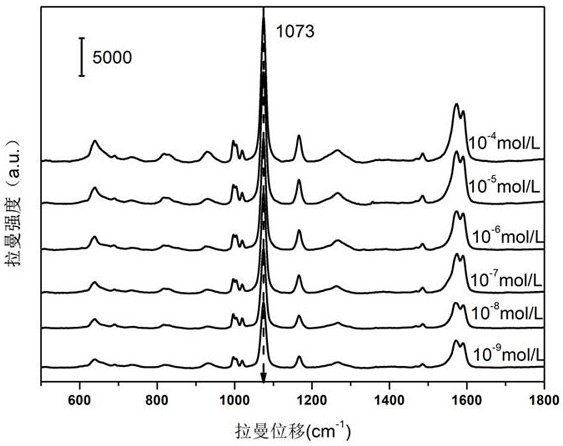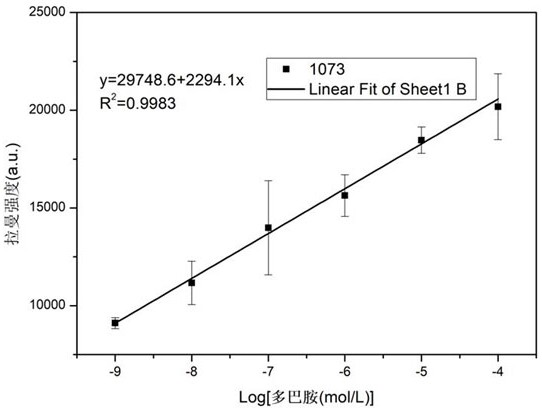Preparation and application of a surface-enhanced Raman sensor for bimolecular recognition of dopamine
A surface-enhanced Raman and dopamine technology, applied in Raman scattering, instruments, scientific instruments, etc., can solve the problems of cumbersome sample processing, large sample volume, poor SERS signal, etc., achieve high sensitivity and selectivity, and simple preparation method. , to avoid the effect of potential interference
- Summary
- Abstract
- Description
- Claims
- Application Information
AI Technical Summary
Problems solved by technology
Method used
Image
Examples
Embodiment 1
[0041] Preparation of a surface-enhanced Raman sensor for bimolecular recognition of dopamine
[0042] (1) Preparation of silver-coated glass sheet with Raman enhancement effect by silver mirror reaction
[0043] Put the 1cmx1cm glass slice into ethanol, acetone, deionized water and ultrasonically clean it for 10min respectively. Configuration of silver ammonia solution: add 0.5-1mL of concentrated ammonia water dropwise to 50mL of 2% (mass fraction) silver nitrate solution, and shake while adding dropwise. Spread the glass slides in a petri dish, pour 20mL of silver ammonia solution, shake gently, then add 1-1.5mL of 6% (mass fraction) glucose solution, heat in a water bath for 15min, the temperature of the water bath is 70°C-80°C;
[0044] (2) Preparation of silver-coated glass sheet modified with mercaptopropionic acid
[0045] Drop 100 μL of mercaptopropionic acid (MPA) 5mmol / L on the 1cmx1cm silver-coated glass slide prepared in step (1), incubate at room temperature fo...
Embodiment 2
[0052] Quantitative detection of dopamine
[0053] The bimolecular recognition dopamine surface-enhanced Raman sensor prepared in Example 1 is used to quantitatively detect dopamine, and the concentration of dopamine is as follows: 10 -4 mol / L, 10 -5 mol / L, 10 -6 mol / L, 10 -7 mol / L, 10 -8 mol / L, 10 -9 mol / L, 10 - 10 mol / L, 10 -11 mol / L, 10 -12 mol / L, 10 -13 mol / L; Add it on the silver film modified with mercaptopropionic acid prepared in Example 1 step (2), incubate at room temperature for 45min, wash with distilled water for 5min, and then add dropwise 100 μL of the solution used in Example 1 step (4) after drying. The cubic nano-silver modified with mercaptophenylboronic acid was incubated at room temperature for 40 minutes, washed with distilled water for 5 minutes, and tested by Raman spectroscopy; the spectra were recorded by a Raman spectrometer with an excitation wavelength of 785nm and an excitation power of 2.5mw, and 5 spectra were taken. Plot the average v...
Embodiment 3
[0055] Selective detection of dopamine
[0056] The bimolecular recognition dopamine surface-enhanced Raman sensor prepared in embodiment 1 is used for the specific detection of dopamine, and 10 in embodiment 2 -4 mol / L of dopamine is replaced by 10 -4 mol / L uric acid, tyrosine and glucose. Detect 5 spectra and take the average value, select 1073cm -1 The intensities of the peaks are compared, as Figure 5 As shown, it can be seen that a strong response is obtained only in the presence of dopamine. However, no significant signal was present in the presence of a large excess of xenobiotics, suggesting no significant interaction between the other interferents used in the assay and the recognition molecules (mercaptopropionic acid and mercaptophenylboronic acid). The selectivity is mainly attributed to the unique molecular structure and a kind of phenolic hydroxyl group and amine group, which react with borate and mercaptopropionic acid respectively, indicating that the senso...
PUM
| Property | Measurement | Unit |
|---|---|---|
| particle diameter | aaaaa | aaaaa |
| quality score | aaaaa | aaaaa |
Abstract
Description
Claims
Application Information
 Login to View More
Login to View More - R&D
- Intellectual Property
- Life Sciences
- Materials
- Tech Scout
- Unparalleled Data Quality
- Higher Quality Content
- 60% Fewer Hallucinations
Browse by: Latest US Patents, China's latest patents, Technical Efficacy Thesaurus, Application Domain, Technology Topic, Popular Technical Reports.
© 2025 PatSnap. All rights reserved.Legal|Privacy policy|Modern Slavery Act Transparency Statement|Sitemap|About US| Contact US: help@patsnap.com



